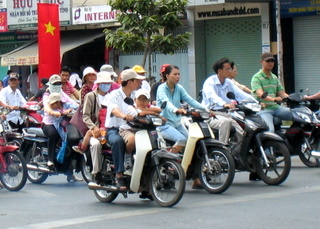|
Situated
in the fertile Mekong Delta, the bustling commercial centre of Vietnam is a
reflection of an industrious people striving towards progress and prosperity.
The city is overflowing with cars and motorbikes, and the footsteps of
the typical worker here seems to be travelling twice as fast compared to the
more relaxed towns and cities in the other parts of the country.
Yet notwithstanding the modern day high-rise buildings and shopping
complexes, Ho Chi Minh City also encompasses significant chapters of Vietnamís
poignant historical past.

Known otherwise as
Saigon during French and American days before the countryís reunification on
30 April 1975, Ho Chi Minh Cityís main tourist attractions are found mainly in
District 1 which lies adjacent to the Saigon River. District 5 or Cho Lon (literally big market) is another
interesting location to explore where many ethnic Chinese have set up residence,
and hence this area is also commonly referred to as Vietnamís Chinatown.
Places of interests in the city
worth a visit include the following:
Reunification Palace,
once a symbol of the South Vietnamese government before reunification, was the
place where the long-drawn American War finally came to an end when North
Vietnamese tanks rolled past the gates to seize control of the Southern
governmentís central administration.
War Remnants Museum, capturing the
poignant yet painful memories of past battles and struggles on the road to
Vietnamís independence, reiterates to its visitors that wars exact much
suffering from both civilians and military.
 Ben
Thanh Market, the most popular
market in District 1, has an extensive array of interesting items ranging from
Vietnamese handicraft souvenirs to cashew nuts and dried lotus seeds. Ben
Thanh Market, the most popular
market in District 1, has an extensive array of interesting items ranging from
Vietnamese handicraft souvenirs to cashew nuts and dried lotus seeds.
Notre-Dame Cathedral,
an astounding architectural feat built in 1880s for French parishioners living
in Saigon, still leaves an aurora of lingering French influence in the crowded
city.
Main Post Office, another impressive architecture by the French built
in the 1880s, currently still carries out its main postal operation just like the
good old days.
|